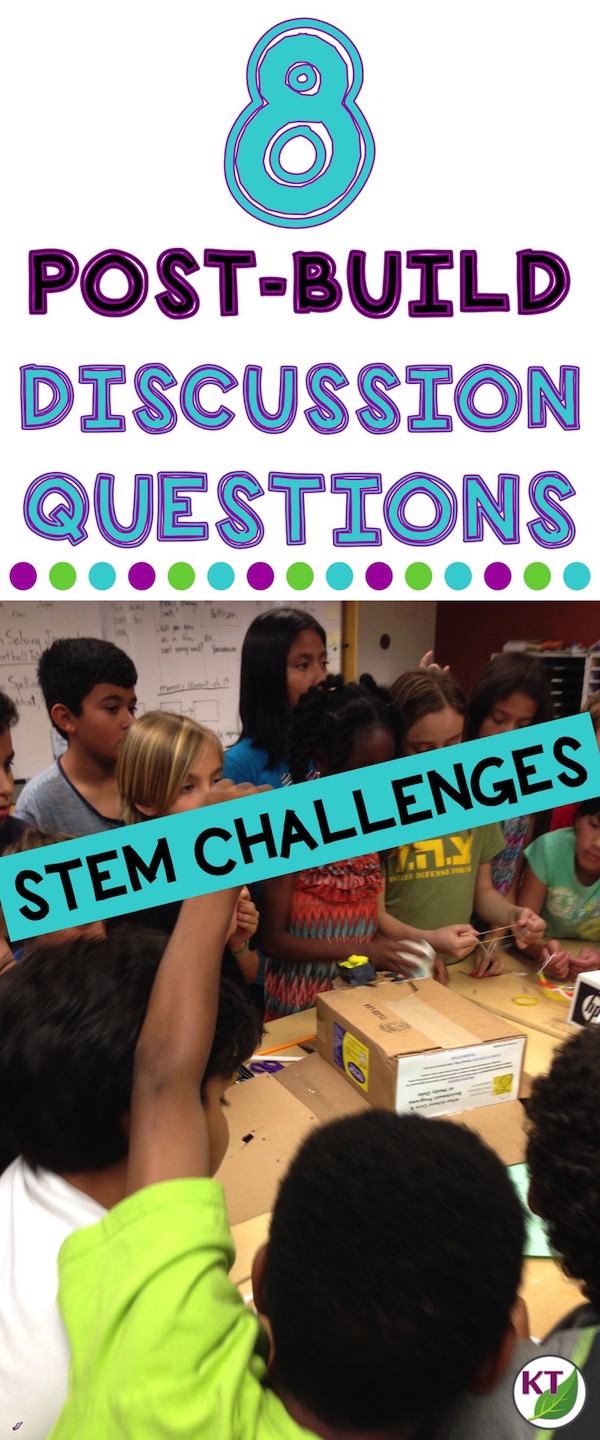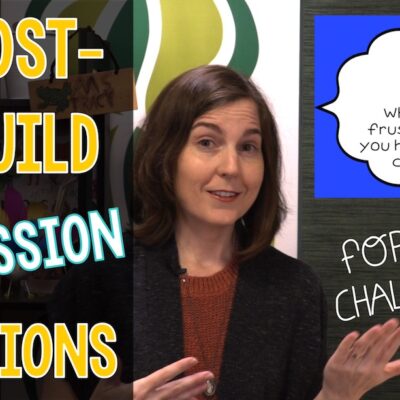Last week, I shared with you how vital the post-build activities are to getting all goodness from your STEM Challenges. If you’re going to devote the time, you may as well get every last drop of value, right?! In addition to the gallery walk, present/demo, Q&A, and individual design analysis, I find the group discussion absolutely invaluable in helping my students process what they actually learned from the challenge! STEM Challenges are fun, but they can be so much more: fun with SUBSTANCE if/when we take the time to do follow-up routines! We can’t assume our students will reflect without dedicated time to do so!
In the video below, I’ll share my eight base discussion questions and a little background on my thinking behind them. You’ll find the transcription at the end of the post if you prefer reading to watching.
I’d love to hear about any questions you might enjoy asking your students!
Feel free to share in the comments, or in the Stellar STEM Teachers Facebook group!
Timing Details
Pin Me

Transcription
Hi, I’m Kerry from Feel Good teaching, and I’m making good on my promise from last week. Last time we discussed what I like to do following the build phase of a STEM challenge. We talked about the gallery walk, allowing students to present, and give demonstrations, the question and answer round, and individual design analysis that I sometimes also call record and reflect. I mentioned that what comes after all those things, for me, is small group and, or, whole class discussion. That’s the topic of today’s video. I believe this group discussion is really important for deepening student’s own reflection and it adds a lot of value to the STEM challenge. This student reflection is key, not just in analyzing their designs, but in actually analyzing the entire process. Because of that, the types of questions I choose in this round go a little bit broader than what I have students do in their record and reflect handouts.
One of my goals is to help students become a little bit more self aware. How are they feeling throughout the challenge? How are they working together as a team? How do those things, as well as a few others, impact the success of their designs? Just like all of the steps we talked about last week, this is one of those things that often gets cut for time in classrooms, but it’s where so much of the value from the STEM challenge can really be found. It’s like when we do a science experiment, and we do all the flash, bang, buzz, and all the fun stuff, but then if we never take those steps to then analyze what does it mean, it can be very tempting to try to convince ourselves that students probably process what the point of the challenge, and how they worked in their teams. Really, we have to assume nothing. If you haven’t done a group discussion following a STEM challenge before, I urge you to give it a try on your next challenge.
I have a set of eight questions that I consider sort of my base. If we’re doing whole class discussions, and I start with those eight, but like a reporter I sort of go where things are interesting. I might ask follow-up questions. I might not in the end do all eight that I had planned, but if students are doing small group discussions, then I do anticipate that they’re going to go through all eight questions.
I like students to think about surprised them during a challenge. Sometimes they’ll come back with things like, “I didn’t think I could do this and then at the last minute it worked out,” or, one time a student said … One of the students in the group was having sort of a little bit of a meltdown. He left the group for a while, when he came back he was really part of the team, and helped them come up with their design ideas at the end. She said she was surprised, and impressed, that he was able to just sort of refocus and then help them do something really wonderful.
I like to find out what was frustrating about a challenge so that one, students can have that opportunity to just express it, and vent if they need to. We can also talk about productive verses unproductive ways to deal with frustration. That also helps me know if I need to make an adjustment to the criteria and constraints list for the next iteration, or if I’m not doing one maybe even just the next school year. Sometimes there are other students in the discussion who can say, “Oh I had that same frustration, you know how we figured it out, we did x, y, x.”
What was the purpose of doing the STEM challenge came from a colleague of mine. What was really fascinating to me is that your students sometimes make connections that you didn’t make. It sort of makes you feel really smart, but it also gives you an opportunity to add in some extensions that maybe you weren’t planning. Then my lofty, maybe pie in the sky goal on this question, I just like students to get in the habit of asking themselves why someone might be asking them to do a certain thing, because I’m hoping as a life skill it might make it harder to manipulate them.
Of course I want students to take the time to look for patterns and designs that worked well and designs that did not. I like students to have the opportunity to share what they’d like to try next, especially if they weren’t successful in this first round. In addition to that, I’d like to know if there’s something they’d want to change about the challenge. Not this might be some materials they’d like added or maybe there was something in the criteria and constraints list that was particularly tricky, so this helps me figure out if there are changes I need, or want, to make to challenge.
Asking students how this does, or could, apply in real life, is another way of asking them to make connections. The big reason in use this question is actually because when I taught seventh grade, and the students had to do science experiment, lab reports, this was always a particular frustration. Students would often just ignore the question completely. This became one of my standards because I don’t want anyone to ever ignore the question. I want it to be very well practiced and very easy to make these connections to the real world.
“Cooperation and collaboration are kind of like cousins,” I tell my students. For cooperation we’re talking about how the students really worked together, it’s their kindness, it’s their respect, are we all pitching, and for me the nuance with collaboration is more about the ideas themselves, and how they make it into the design. Did we listen to everybody’s ideas? Did everybody try to pitch in and help and contribute in some way to the design? Did we try to incorporate ideas from different members of the group? When there was a decision or choice to be made, did we make that choice fairly? This is also an opportunity for you, if you happen to notice during the build there were particular teams working really well together, maybe they did a division of labor, or they had some sort of systems in place, you can sort of tease this out in the way that you ask the discussion questions, to get them to share with the groups. Hopefully teams will start to see that groups that collaborated, and cooperated, well together, tend to produce better designs than those that have a lot of infighting.
For the final question, I choose a different quote for every challenge. I ask the student to explain the quote in their own words, and then describe how it applied to the challenge. The quotes I pull are usually about hard work, determination, perseverance, failure, et cetera. You might be surprised at how insightful your students are with these quotes. You can even use them for writing prompts, and this is actually one of the reasons I like to use a quote, is to get students in the practice of paraphrasing and of course making connections to their own lives. I learn so much by doing these discussions. This time really helps students reflect on the process and really appreciate their own progress as they go through challenges. Remember, don’t assume that the students are going to have these aha moments on their own. We need to dedicate the time to allow them to get there.
Do you have some favorite questions you like to ask your students after design? I would love to hear them. Go ahead and drop them in the comments or join me on my Facebook group, Stellar STEM Teachers. I’ll be back next time with a brand new STEM challenge, so make sure you’re following or subscribed so you don’t miss it. Until then, I hope your week is packed with feel good teaching moments. See ya soon.



